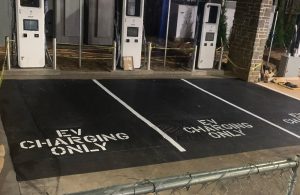— By Conner McGill —
Why retailers and restaurants are investing in EV charging stations.
If electric vehicle (EV) charging has sparked your interest recently, you’re not alone. Retailers and restaurants across the country are giving more consideration to EV charging stations for good reason. We are living in an increasingly electric environment. In fact, the Electric Power Research Institute projects that 35 million EVs will be sold in the U.S. by 2030. As more drivers buy EVs, the demand for places to charge them will follow. Smart retailers and restaurants are realizing that EV charging stations are no longer a convenient amenity. They are an essential asset to stay competitive and benefit the bottom line.
Why Invest?
Investing in EV charging stations has many advantages. Perhaps most important are incentives, positive brand perception, brand loyalty and increased revenue.
Incentives

Conner McGill, Let’s Pave
Installing EV charging stations is more affordable than you might think. Local municipalities, state and federal agencies often provide tax and other incentives to facilitate the expansion and promotion of electric vehicles through the country. Commercial properties can take advantage of these savings to bridge any potential financial gap for installation and construction.
Brand Image
Environmental issues are top of mind for many people today. Consumers increasingly opt to patronize brands that fit their personal values. Whether you manage commercial real estate, retail, restaurants or hotels, installing an EV charging station in your parking lot demonstrates that your brand is concerned about the environment and cutting carbon emissions. Furthermore, EV charging stations may help your business earn environmental accreditation, including LEED credits for EV infrastructure, which can be promoted alongside your brand.
Brand Loyalty
 Consider this scenario: a customer is more likely to shop at a store or eat at a restaurant which provides free charging for his or her vehicle over a comparable property without the amenity. In fact, Blink Charging Co. reports that over 40% of EV drivers are willing to return to locations with EV charging stations on a weekly basis.
Consider this scenario: a customer is more likely to shop at a store or eat at a restaurant which provides free charging for his or her vehicle over a comparable property without the amenity. In fact, Blink Charging Co. reports that over 40% of EV drivers are willing to return to locations with EV charging stations on a weekly basis.
Similarly, hotel guests that drive long distances prior to arrival must have the ability to recharge their EVs. No doubt they will choose a property that offers charging stations and remain loyal to that brand throughout their road trip and beyond.
Increased Revenue
EV owners tend to be higher earning than the average population with greater disposable income (source: IHS Markit/Cox Automotive). This means they have the potential to spend more money at your stores or restaurants. And, because EVs take time to charge, drivers are also more likely to plug in and stay at your property for a longer duration. According to The Drive.com, depending on the type of charger used, it can take anywhere between 25 minutes and several hours to recharge. More time to linger and browse increases the likelihood of purchasing more products, services or, in the case of dining, staying for dessert.
In addition, many EV ports are equipped with LED screens on which digital advertising can be featured. Selling ad space here will generate additional revenue as well.
Lead the Charge
Ready to lead the charge? Work with an installation specialist to determine location, clustering and other optimization considerations that make sense for your business.
Also consider whether you will install networked or non-networked chargers. Networked charging stations are necessary if the stations will be restricted to certain people and if you plan to charge for the electricity.
 Once you have determined layout/design and selected equipment, the installation process can begin. Depending on available electrical service, site location and data connectivity, the process can be complex and require varying levels of site work along with expertise in a multitude of trades.
Once you have determined layout/design and selected equipment, the installation process can begin. Depending on available electrical service, site location and data connectivity, the process can be complex and require varying levels of site work along with expertise in a multitude of trades.
On existing parking lots, the infrastructure must be prepared. Making the site ready involves a tremendous number of moving parts, all requiring specialized skillsets. This can be the most time-consuming part of the install, so it is important to choose a partner with extensive experience to protect your property and customers.
First, demolition and removal of asphalt and concrete occurs to accommodate underground utilities. Next, concrete pads are poured. Charging ports are mounted and installed on the concrete pads. Asphalt and concrete assets such as bumper blocks and curbing are replaced. Last, but not least, signage is installed, and markings are applied to designate stalls for EV charging.
EVs are increasing in popularity and the demand for charging stations is accelerating. Investing in EV charging stations now will put your stores and restaurants on the map of the emerging EV market. In doing so, your brand will promote sustainability and clean transportation options, attract a high-end, environmentally friendly customer base, and increase revenue.
— Conner McGill, senior manager of complex and capital projects, has worked in the national parking lot management industry for over 10 years. Currently, he manages complex special programs at Let’s Pave including turnkey installation of EV charging stations.
